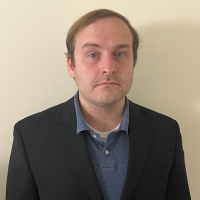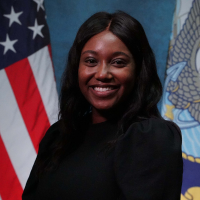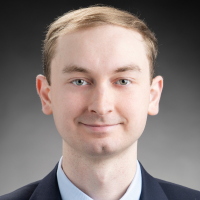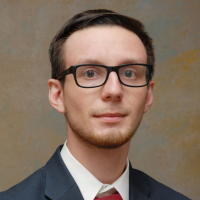2024 Future 5 Awardees
Each year, AOC showcases five young professionals as the year's Future 5, recognizing those who actively innovate and strive for excellence as they build their careers in the EMS/EW/IO industry.
Please join us in celebrating this year’s Future 5.

Matthew Copeland
Electronics Engineer, DOD - C5ISR Center - RTI - CEMA Division - IOEW Branch
Career Goal
My ultimate career goal is to help save a soldier’s life. Early in my career I had trouble understanding the impact of the work that I was doing, since I was fixated on my small task instead of how it contributed to the entire military. My interest in work was reinvigorated when I was able to begin researching threats and EW capabilities. I was able to understand a variety of ways that the EMS was utilized and how it was being used by our adversaries to potentially put our soldiers in danger. Suddenly, I was focusing on understanding how these systems worked and how everything works together since I needed to discover how threats can be defeated to protect our troops. When I transitioned to working as a civilian employee for the C5ISR Center, I was finally able to apply what I had learned to provide direction to my branch and highlight opportunities for further work. On the Susquehanna chapter’s coin this year we put a quote from a soldier in binary that said, “EW saved my life”. This resonated with our committee and me because it highlights the importance of the work that we are doing. If someday I hear a story at a summit or on the news about something that I worked on helping to intercept a missile, take the first shot, or give a solider enough time to retreat, I will have used EW to help save a life. That is my ultimate career goal.
Career Achievement
In February 2024, I was able to help present a briefing to a four-star general. General Rainey, the head of Army Futures Command, was coming to APG to learn about work being done at the C5ISR Center. Originally, I was not planning to help present to the general. Senior leadership wanted to present on a project I had been working on for the past few years, so I made new slides on the recent success stories of the program. I briefed my slides and answered any questions that senior leadership had, so they could present the topic to the general. We spent some time, as a team, modifying the slides to ensure that our story was concise and understandable. When we felt that the everything was ready, we finalized the presentation and waited for the day of the visit. Unfortunately, the day before the general was set to arrive, the primary presenter fell ill and had to back out. I was asked to help present, since I was familiar with the slides and could help to answer any questions. The new team of presenters, including myself, met to finalize our revised plan and discuss how I would be helping with the presentation. The next day, the general showed up and we were able to put our presentation plan into action. The presentation went off without a hitch, and we were thanked afterwards in the public assembly where he called all the presenters to the front and gave us commemorative coins.
Education
B.S. Electrical Engineering

Imani Davis
Computer Scientist, Naval Surface Warfare Center, Crane Division
Career Goal
My ultimate career goal within the EMS industry is to facilitate the convergence of cyber and electronic warfare through research and development, workforce development, and improved collaborations across various communities. At its maturity, this requires the execution of multiple smaller efforts that will grow and intertwine to create a cyber-EW community. If I were to put this into a position, it would be a Chief Scientist or Engineer. This role would enable me to be a technical advisor, identify opportunities for research, ensure our capabilities meet the mission, and most importantly, grow and mentor our rising engineers. My current role for the Electromagnetic Warfare Science and Technology Division allows me to explore the current cyber-EW landscape, expand our opportunities for collaboration, and grow our digital payload capabilities to include RF-Enabled cyber. In this role, I’ve further developed my leadership skills and have been exposed to the requirements and challenges of developing a new capability for an organization. These lessons learned will be very useful on my path to growing the cyber-EW coalition for Crane and navigating how to expand this culture across the DoD. The visibility of this role has connected me with engineers who have similar cyber backgrounds, but were lost at how they could contribute to an EW mission. I am grateful to be able to help them explore the various applications and opportunities for integrating cyber into the EW world. Throughout my career, I aim to continue to pave the way for new capabilities and efforts with the hope to motivate and uplift the rising engineers in our community.
Career Achievement
My biggest career achievement has been my ongoing effort to establish a Cyber/EW portfolio for the Spectrum Department of my organization. This has consisted of multiple smaller steps, ultimately leading up to the opportunity to launch our RF-enabled cyber capabilities. Recently, I was able to secure internal development funds for a small team to execute our first project that explores using offensive cyber techniques such as packet manipulation to disrupt situational awareness within a targeted location. Though technical successes are one of the goals of any R&D project, we are also leveraging this opportunity to make external connections, socialize our vision for RF-enabled cyber, and understand limitations related to infrastructure and resources. It has been both challenging and exciting to pave the road for a new area of research for our organization, and the Navy as a whole. However, one of my favorite effects of this achievement has been showing the other cyber engineers in my organization that there can be a spot for us in the EMSO industry.
Education
M.S. Cybersecurity Technology, University of Maryland Global Campus
![]()

Michael Gutierrez
Software Engineer, Palantir Technologies, Inc.
Career Goal
I envision my career in the EMS/EW/IO industry to be defined by my role in building at least one successful EW-focused technology company and my contributions to individuals and companies pursuing work in the national security interest. To me, it is important to educate young Americans about the reality of national security and open the doors for the best and brightest talent in America to lend their talents to defense technologies. To foster an environment to encourage solving difficult problems within defense, I aim to evolve my community efforts into higher impact channels that more deeply connect builders with the personnel and channels through which they can best equip the warfighter with their capabilities. As a means to help ensure that the United States captures and maintains spectrum supremacy, I would like to commit the efforts of an EW company to developing software-defined systems that unlock new paradigms for electronic attack, defend, and support. My experiences working with directed energy and sensor data platforms showed how quickly spectrum warfighting is evolving. And through listening to the goals, challenges, and needs of various operators in the electromagnetic domain, I believe there lies great opportunities to more intently leverage software and algorithm innovations to assemble complex systems that are dramatically more capable than the sum of their parts. To that end, I have begun by contributing to the incubation of a startup company focused on new sense platforms for improved spectrum awareness as well as large-scale electronic support software at Palantir.
Career Achievement
While I rarely heard conversations centered around nation security during my time at university, my interest in the subject convinced me that there were other students and recent graduates who were passionate about tackling these types of problems. As such, with three of my close friends, we hosted our first defense technology hackathon in New York City. The overwhelmingly positive responses from our dozens of attendees showed us that there was real excitement around having a space to share with others working in defense. Only a few months later, we hosted another hackathon in El Segundo, California with more partners from industry and government. One weekend and hundreds of attendees later, five new startups were incorporated, tens of millions of dollars in venture capital funds were deployed, nearly 25 new jobs in defense were filled, and multiple new hackathons were soon scheduled around the world. From both first time hackathon participants and repeat defense startup founders, attendees relayed how thrilled they were to have a passionate environment wherein they could meet new friends and co-founders, collaborate on new capabilities, and incorporate real feedback from military and industry experts. I am proud to have been a part of the organizing teams and of the outcomes that these hackathons have brought to the national security industry. The breadth of talent, the creations constructed, and the follow on support that came together for these events has made me very optimistic that defense technology is the right place for me to continue my career.
Education
B.S. Computer Science, Columbia Engineering

Paul Kennedy
Section Supervisor, Johns Hopkins University Applied Physics Laboratory
Career Goal
When I look back on my career, I hope to say that I helped our warfighters. That I made a difference. To realize this ultimate goal, I aspire to make critical contributions as a leader and defining innovations as a technical contributor.
One of the most rewarding experiences in my professional journey has been my time as a section supervisor. As a line manager, I get to participate in the career journeys of my staff, help shape their development, coach them on how to execute their innovative ideas, and celebrate their success. Our warfighters face big challenges in the EMS, and the only way to solve these challenges is as a team. In my role as a leader, creating a culture of innovation and collaboration is paramount for achieving mission impact.
As a technical contributor, my growth is driven by my curiosity and love of learning. Being part of the rapidly evolving field of EW is intellectually fulfilling and offers many opportunities for creative problem solving. Intellectual growth has been a major reason for my involvement in the AOC – learning through summits, local Roost tech talks, or the latest edition of JED. Synthesizing information across technical silos is essential for creating truly innovative solutions. As I learn more across various specialties within EW, I aspire to use this knowledge to form unique solutions that help our warfighters.
Ultimately, I aim to use my career to serve my family, my nation, and the warfighters that protect them.
Career Achievement
Leading a project from its inception is intellectually freeing and rewarding – but also scary and challenging. For this reason, leading an Internal Research and Development (IRAD) effort as Principal Investigator has been my biggest career achievement. Working with my team, I was able to take a novel idea for collaborative EW through concept development, modeling and simulation, prototype development, and demonstration.
Leading an IRAD challenged me to develop new skills. Managing the budget, holding cross-functional team meetings, effectively communicating to stakeholders, and managing expectations while also selling our achievements. The technical challenge also required me to think outside the box – to challenge the status quo. IRAD funds offered an opportunity to break free from the traditional acquisition structure driven by platform-centric programs and allowed me to explore fielding cross-platform kill chains and technologies.
Sharing this work at the 2024 AOC Collaborative EW Symposium was especially rewarding. Much of our work in this industry has very limited distribution, so I was excited to share my ideas with new people. I found the summit presentation to be a unique and exciting communication challenge. People come from such diverse backgrounds, whether as operators, engineers, or program managers, to attend these summits, and an effective presentation must communicate clearly to all levels while still conveying technical depth to those familiar with the research area.
Overall, developing new technical, communication, and management skills to successfully lead my IRAD effort has been my biggest career achievement.
Education
M.S. Electrical Engineering, Virginia Tech

Paul Wilkowski
Senior Specialist, Systems Engineer, L3Harris Technologies
Career Goal
My ultimate career goal is to be a disruptor within the Defense Industry; driving not only the new technological pipelines but to also to architect large-scale solutions with our customers which would drastically improve their capabilities and effectiveness. While I currently view a majority of the industry products developed to be one-dimensional, I am looking to harness the ideologies of Open System Architecture and Multifunction Processing in product development. This allows the team that I look to lead to develop innovative technologies at a rapid pace in all aspects of Electromagnetic Spectrum Operations. While personally I may not have executive expertise in all of the EMSO domains, I will lead a multifaceted team where we will quickly deploy effective capabilities into the hands of the warfighter; such that they can successfully execute their missions and return home safely to their families.
I have already laid a solid foundation to achieve this goal. I have earned technical degrees in both Electrical and Systems Engineering which have granted me the opportunities to work at some of the largest DoD Contractors such to develop Avionics, C4ISR, and EW products; bestowing an understanding of the various perspectives of the warfighter's mission. I am pursuing my Master of Business Administration degree in order to hone my financial and entrepreneurial skills such to be able to go to the table with industry leaders to secure funding for my ideas and effectively manage teams to implement them. And lastly I have established a culture of continuous improvement on my teams such that we do not only ensure we improve our products everyday but also the process in which we develop them.
As I continue down my career path, I am looking to empower the not only the best, brightest, and most experienced in their individual domains but also to elevate those curious yet passionate in the areas of EMS/EW/IO, such that together we can introduce technologies which truly disrupt the industry.
Career Achievement
Being involved with music ensembles since elementary school, I was always taught to follow the beat of the conductor. While I did not pursue a professional career in music, I have now found myself to be the 'conductor' of a multi-million dollar development at L3Harris Technologies. Currently I am working on L3Harris' next-generation all-digital/software-defined Electronic Warfare suite. This is (thus far) my biggest career achievement; leading the orchestra of engineers through the highs and lows of integration as we work towards bringing the warfighter home. The system in development is comprised of 6 Line Replaceable Units (LRUs) providing Radar Warning Receiver (RWR) and Electronic Countermeasures (ECM) with Digital RF Memory (DRFM) capabilities. A key technical differentiator between this system and other EW suites is its interoperability with the platform's AESA Fire Control Radar (FCR).
As one of the system's lead engineers, I have the privilege of integrating all of the external interfaces within the system. My day consists of working with the various design engineers implementing the required capabilities; I ensure we are all performing on the same beat and transitioning together through the movements of the project. When a setback occurs, we work through it together because as Miles Davis said “when you hit a wrong note, it’s the next note that makes it good or bad.” Together, the team and I have delivered Engineering/Manufacturing Development (EMD) systems to our customer such to demonstrate our capabilities in their System Integration Lab (effectively modeling on-platform usage) along with to the Integrated Demonstrations and Applications Laboratory (IDAL) at Wright-Patterson Air Force Base such to demonstrate our RWR performance against advanced threats. We are currently executing Safety of Flight Testing, where we ensure that the system meets key environmental and electrical requirements such that the system can enter Flight Test.
Education
Master of Engineering, Systems Engineering, Cornell University
B. S. Electrical Engineering, Syracuse University
